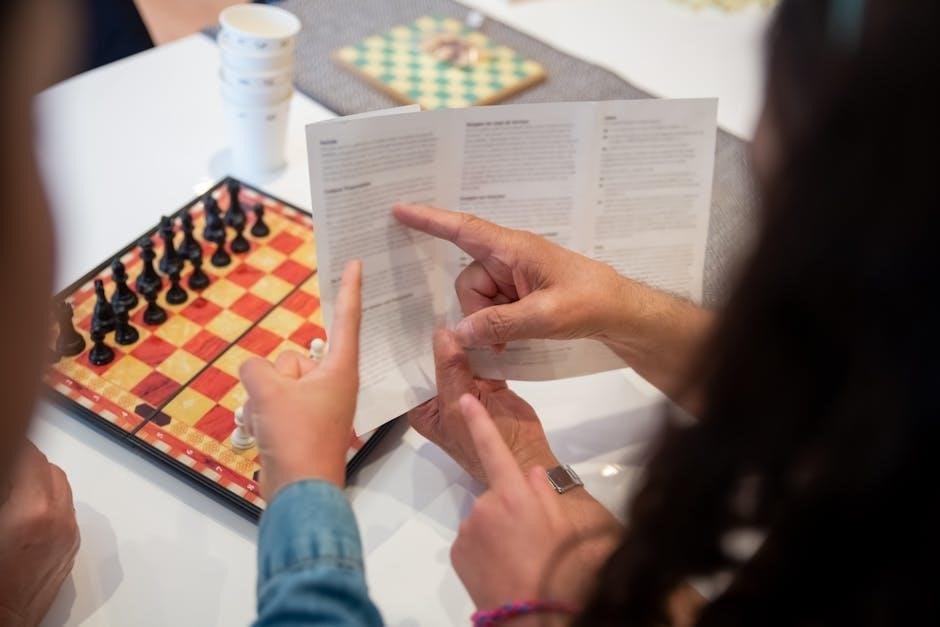rules of cribbage pdf
Cribbage is a classic card game for two to four players, using a standard 52-card deck․ Players score points through combinations like pairs, runs, and fifteens, aiming to reach 121 points first․ The game combines strategy and luck, with a unique scoring system and a crib hand for the dealer․ Understanding the rules is essential for mastering this popular card game․
Overview of the Game
Cribbage is a strategic card game for two to four players, played with a standard 52-card deck․ The objective is to be the first to score 121 points by forming combinations like pairs, runs, and fifteens․ Players take turns laying cards on the table, announcing cumulative totals․ The dealer also has a special hand called the crib, which is scored separately․ The game combines luck and skill, with a unique scoring system that rewards both quick thinking and long-term strategy․ Understanding the rules and scoring combinations is key to mastering this popular and enduring card game․
Importance of Understanding the Rules
Understanding cribbage rules is crucial for enjoying the game and ensuring fair play․ The game’s complexity, with its unique scoring combinations and crib mechanics, requires a clear grasp of the rules to avoid disputes․ Knowing how to score pairs, runs, fifteens, and nobs ensures players can maximize their points․ Additionally, understanding the crib’s role and how it is scored helps dealers make strategic decisions․ Without a solid understanding of the rules, players may miss scoring opportunities or make incorrect plays, leading to confusion and frustration․ Mastery of the rules enhances the game’s enjoyment and competitive balance for all players involved․

History of Cribbage
Cribbage, invented by Sir John Suckling in 1635, has remained a popular card game with minimal rule changes․ Its enduring appeal spans centuries, adapting across cultures while retaining its core charm․
Origins of the Game
Cribbage was invented by Sir John Suckling, a British poet and knight, around 1635․ It quickly gained popularity in England and spread across the English-speaking world․ The game’s original rules remained largely unchanged, making it one of the most enduring card games in history․ Its simplicity and strategic depth contributed to its widespread appeal․ Over time, cribbage became a staple in both casual and competitive settings, with its origins rooted in 17th-century England․ The game’s longevity is a testament to its engaging gameplay and universal appeal․
Evolution of Cribbage Rules
Cribbage rules have remained largely consistent since its invention by Sir John Suckling in 1635․ The game’s original structure, including the use of a 52-card deck and scoring combinations, has endured․ However, as cribbage spread across the English-speaking world, minor variations emerged, particularly in tournament play․ Standardization efforts, such as those by the American Cribbage Congress, helped unify rules for competitive settings․ Despite these changes, the core gameplay and scoring system have remained intact, ensuring cribbage’s timeless appeal and accessibility for players of all skill levels․
Setup and Equipment
A cribbage board with pegs and a standard 52-card deck are essential․ The game typically involves two to four players, with the board tracking points effectively․
Cribbage Board and Pegs
The cribbage board is a flat, rectangular board with 120 holes, used to track players’ scores․ Each player uses two pegs, typically of different colors, to mark their progress․ The board features a starter hole at the top, where pegs begin, and is divided into sections of five holes each․ Pegs are moved forward as points are scored, with the goal of reaching the final hole․ The board’s design allows for easy tracking of cumulative scores, ensuring clarity during gameplay․ The “go” peg is often used to mark missed counts, adding strategic depth to scoring․
Standard 52-Card Deck
A standard 52-card deck is used in cribbage, without jokers․ The deck includes 13 ranks (Ace through King) in four suits․ Cards rank from King (highest) to Ace (lowest)․ Tenth cards (King, Queen, Jack, and 10) count as 10 points, while other cards count as their face value․ Aces are worth one point․ The deck is shuffled and cut before dealing, ensuring randomness․ Each player receives six cards in a two-player game, with the remaining cards forming the stock pile․ The starter card, turned over after dealing, influences scoring combinations during gameplay․
Number of Players
Cribbage is typically played with two players, but variations allow for three, four, five, or six players․ The core rules remain consistent, but setups like three teams of two require adjustments, such as how the crib is formed from discards․ This flexibility makes cribbage accessible to various group sizes while maintaining its strategic depth․

Dealing the Cards
The deck is cut, and the player with the low card deals․ After shuffling, six cards are dealt alternately to each player, starting with the non-dealer․ The remaining cards are placed face down, and the top card is turned over as the starter․ This process ensures fair distribution and prepares the game for play․
How the Deck is Cut
The deck is cut to determine the dealer, with the player drawing the lowest card winning the deal․ In case of a tie, players draw again․ The non-dealer cuts the deck, and the dealer shuffles before distributing the cards․ This process ensures fairness and randomness, setting the stage for the game․ The cutting procedure is a critical step in initializing the game, ensuring equal opportunity for all players․ Proper cutting and shuffling are essential for a fair and enjoyable game of cribbage․
Distributing the Cards
After cutting, the dealer shuffles the deck and distributes the cards alternately to each player, starting with the non-dealer․ Each player receives six cards in a two-player game․ The dealer ensures cards are dealt face down, maintaining the game’s integrity․ Players must keep their cards private to prevent opponents from gaining an advantage․ The precise distribution method guarantees fairness and prepares players for the gameplay ahead․ This structured process is crucial for maintaining the balance and enjoyment of the game․
The Starter Card
The starter card is a critical element in cribbage, determining the initial gameplay flow․ After dealing, the top card of the remaining deck is turned over as the starter․ This card is essential for scoring combinations during the game․ The non-dealer begins by playing a card, followed by the dealer, with each announcing the cumulative total․ The starter card also influences the crib, as it is included in the dealer’s hand for scoring․ Proper handling of the starter card ensures fair play and accurate scoring throughout the game․

Gameplay Overview
Cribbage begins with dealing cards and turning over a starter card․ Players alternate playing cards, announcing cumulative totals, aiming to score points through combinations like pairs, runs, and fifteens․
Objective of the Game
The objective of Cribbage is to be the first player to score 121 points․ Points are earned through various card combinations, such as pairs, runs, fifteens, flushes, and nobs․ Players alternate playing cards, announcing cumulative totals, and scoring points based on these combinations․ The game requires strategic thinking and luck, as players aim to maximize their scores while minimizing their opponent’s opportunities․ The unique scoring system and the crib hand for the dealer add layers of complexity, making Cribbage a challenging and engaging card game for players of all skill levels․
Non-Dealer’s First Move
The non-dealer begins by laying a card face up on their side of the cribbage board․ This card is announced aloud, such as “five” if a 5 is played․ The non-dealer’s first move sets the stage for the game, as subsequent plays by both players will build on this initial card․ The goal is to play a card that maximizes scoring opportunities while minimizing the dealer’s chances to score․ After the non-dealer plays, the dealer follows with their own card, and the game progresses with alternating plays, each player announcing the cumulative total of cards played․
Alternating Plays
After the non-dealer’s first move, players alternate turns, each laying a card face up on their respective sides of the cribbage board․ The non-dealer plays first, followed by the dealer, and this pattern continues throughout the game․ Each player announces the cumulative total of all cards played so far, such as “five” or “twenty-one․” This alternating play creates a dynamic interplay between the two sides, as players aim to maximize their scoring opportunities while minimizing the opponent’s chances to score․ The game progresses until all cards are played, with the goal of reaching 121 points first․
Announcing Cumulative Totals
During play, each player must announce the cumulative total of all cards played after laying down their card․ For example, if the non-dealer plays a 5 and the dealer plays a 7, the dealer announces “12․” This running total is crucial for scoring combinations like fifteens, which award 2 points․ Players alternate turns, and the totals are tracked on the cribbage board using pegs․ Accurate announcements ensure fair play and help players strategize their moves to maximize scoring opportunities․ This practice is essential for maintaining the game’s flow and ensuring all points are accounted for correctly․

Scoring in Cribbage
Scoring in cribbage involves points for pairs, runs, fifteens, flushes, and nobs․ Players earn 2 points for pairs, 3 for three-card runs, and 2 for fifteens․ Flushes and nobs add extra points, with the dealer’s crib offering additional scoring chances․ Tracking these combinations strategically helps players reach the winning score of 121 points efficiently․
Scoring Combinations
In cribbage, scoring combinations are key to earning points․ Pairs (two cards of the same rank) score 2 points, while three-card runs (sequential cards) earn 3 points․ Fifteens (card combinations totaling 15) award 2 points․ Flushes (four cards of the same suit) grant 4 points, and nobs (a jack of the same suit as the starter card) add 1 point․ These combinations can be formed during play or in the crib, with the dealer’s crib offering additional scoring opportunities․ Understanding these combinations is crucial for maximizing points and securing victory․
Points for Pairs
In cribbage, pairs are scored when two cards of the same rank are played․ Each pair earns 2 points․ If a player has three cards of the same rank, they score 3 pairs, totaling 6 points․ Four-of-a-kind results in 6 pairs (12 points)․ Pairs are announced during play, and the points are pegged on the board․ This scoring combination is a fundamental part of the game, rewarding players for matching cards strategically․ Understanding how to identify and maximize pairs is essential for improving your cribbage skills and increasing your chances of winning․
Points for Runs
In cribbage, runs are sequences of three or more consecutive cards․ Each run scores points equal to the number of cards in the sequence․ For example, a run of three cards scores 3 points, while a run of four cards scores 4 points․ Runs can be formed by any combination of cards in sequential order, regardless of suit․ If multiple runs are possible, players can score for each distinct sequence․ Runs are a key part of cribbage strategy, as they offer significant scoring opportunities during play and in the crib․ Maximizing runs requires careful planning and card management․
Points for Fifteens
In cribbage, points for fifteens are awarded when a player’s cards add up to exactly 15․ Each combination of cards totaling 15 scores 2 points․ For example, a 10 and a 5, or a 9, 4, and 2, each count as 15․ Multiple combinations in a single hand can score separately, as long as the total is 15․ Fifteens are counted during the play phase and in the crib․ This scoring rule adds a strategic layer, as players must think about how their cards can sum to 15 in different ways․ It’s a key part of maximizing points in the game․
Points for Flushes
A flush in cribbage occurs when all four cards in a hand are of the same suit․ A four-card flush scores 4 points, while a five-card flush (including the starter card) scores 5 points․ The flush is scored during the show phase, after all hands are revealed․ Importantly, the crib hand can also score a flush if all four cards are the same suit․ A flush is a valuable scoring combination, rewarding players for having cards of a single suit․ It’s a key part of the game’s strategy and can significantly impact the final score․
Points for Nobs
A “Nob” in cribbage is scored when a player holds the Jack of the same suit as the starter card․ This unique combination awards 1 point․ The Nob is revealed during the show phase, after all hands are exposed․ It is a distinctive scoring opportunity, as it relies on the specific suit of the starter card․ Players must carefully track the starter card’s suit to identify potential Nobs in their hand․ This scoring combination adds a layer of strategy, as players aim to maximize points through this rare but valuable opportunity․ The Nob is a key part of cribbage’s intricate scoring system․

The Crib
The crib is a special hand in cribbage, consisting of the dealer’s discarded cards and the starter card, offering unique scoring opportunities during the game․
What is the Crib?
The crib is a unique hand in cribbage, set aside during the main play, consisting of the dealer’s discarded cards and the starter card․ It is scored separately after the main game, offering additional points through combinations like pairs, runs, and nobs․ The crib is a key part of the game, providing the dealer with exclusive scoring opportunities․ Understanding how to evaluate and maximize the crib is essential for strategic play․
Scoring the Crib
Scoring the crib occurs after the main play, using the dealer’s crib hand and the starter card․ Points are awarded for combinations like pairs, runs, fifteens, flushes, and nobs․ A pair in the crib scores 2 points, while three of a kind scores 6․ A run of three or more consecutive cards adds points equal to the number of cards in the sequence․ Fifteens in the crib score 2 points per combination, and a flush with four cards of the same suit adds 4 points․ Nobs, a jack of the same suit as the starter card, scores 1 point․ The crib is a strategic part of the game, offering the dealer exclusive scoring opportunities․

Winning the Game
The first player to score 121 points wins, marking the end of the game․ Reaching this threshold concludes the competition, determining the victor․
Winning Score
The winning score in cribbage is 121 points, achieved by pegging or scoring combinations․ The first player to reach this total wins the game, ending the competition immediately․ This threshold ensures a clear victor, concluding all scoring and play․ The game’s conclusion is straightforward, with no additional rounds once 121 points are attained․ The focus on reaching this specific score adds structure and clarity to the game’s objective, ensuring a definitive outcome for players․
Reaching 121 Points
Reaching 121 points is the ultimate goal in cribbage, marking the end of the game․ This score is achieved through strategic play, combining pegging, hand scoring, and crib contributions․ The player who first accumulates 121 points wins, ensuring a clear victor․ The game concludes immediately upon reaching this threshold, with no additional rounds played․ This specific target provides a definitive endpoint, ensuring the game remains structured and competitive․ Achieving 121 points demonstrates mastery of cribbage’s scoring system and strategic execution, making it a celebrated milestone for players․
The game concludes when a player reaches or exceeds 121 points, with the winner being the first to achieve this score․ Upon reaching 121, the player pegs out, marking the end of the game․ All remaining points, including those in the crib, are tallied to finalize the winner․ The conclusion ensures a clear resolution, with no further play after the winning score is attained․ This structured endpoint adds to the game’s appeal, providing a satisfying finish to the competition․

Variations of Cribbage
Cribbage can be played with three or four players, adapting the core rules for team or individual play․ These variations maintain the game’s essence while expanding its appeal․
Three-Handed and Four-Handed Games
In three-handed cribbage, each player receives six cards, and the crib is formed differently, often using discards from all players․ Four-handed games typically involve two teams of two, with partners playing together; The core rules remain consistent, but scoring and gameplay are adjusted for team dynamics․ The crib in four-handed games may include cards from both teammates․ These variations allow for social interaction and strategic teamwork while maintaining the game’s traditional scoring system and objective of reaching 121 points․
Team Play Variations
In team play, cribbage is typically played with four players divided into two teams of two․ The core rules remain the same, but scoring is shared between teammates․ Communication and strategy are key, as teams work together to maximize points․ The crib in team play often includes discards from both teammates, adding a collaborative element․ Team variations emphasize social interaction and shared success, making the game more dynamic․ The objective remains the same: reach 121 points first, but the journey involves coordination and teamwork to outscore opponents․

Strategy and Tips
Cribbage strategy involves mastering scoring combinations and tactical card play․ Beginners should focus on understanding pairs, runs, and fifteens, while experienced players refine discarding and pegging techniques․ Experience enhances skill in maximizing points and outmaneuvering opponents․
Basic Strategies for Beginners
Mastering cribbage starts with understanding scoring combinations like pairs, runs, and fifteens․ Beginners should focus on recognizing these patterns quickly․ Keep track of the cumulative total during play to avoid exceeding 31․ Organize your hand to maximize points, especially in the crib․ Pay attention to the starter card, as it can significantly impact scoring․ Practice discarding strategically to limit the dealer’s crib potential․ Familiarize yourself with the board layout to efficiently track progress․ Learning these fundamentals will build a strong foundation for improving your game and enjoying cribbage fully․
Advanced Tactics for Experienced Players
Experienced players refine their cribbage skills by mastering strategic discarding and pegging․ Focus on minimizing the dealer’s crib potential while maximizing your own․ Pay attention to the starter card to optimize scoring combinations․ Develop a keen sense of when to hold or discard specific cards to control the game’s flow․ Advanced players also excel at tracking opponents’ moves to anticipate their strategies․ Perfecting these tactics enhances your ability to outmaneuver opponents and consistently score high points, particularly in competitive play․
Etiquette and Sportsmanship
Respect and fair play are essential in cribbage․ Players should maintain a positive attitude, avoid disputes, and congratulate opponents on good plays; Sportsmanship fosters enjoyment for all․
Respect for Opponents
Respect for opponents is a cornerstone of cribbage etiquette․ Players should avoid gloating, unsportsmanlike conduct, or disruptive behavior․ Acknowledging good plays and maintaining a positive demeanor fosters a friendly atmosphere․ This ensures an enjoyable experience for everyone involved, promoting camaraderie and fair play․ Respectful communication and graciousness, whether winning or losing, are key to upholding the game’s traditions․ By valuing opponents, players contribute to a positive and inclusive environment, making the game more rewarding for all participants․
Conduct During the Game
Proper conduct during cribbage ensures a smooth and enjoyable experience for all players․ Maintaining focus and avoiding distractions is key, as is keeping track of scores accurately․ Players should place cards face up in the correct areas of the board and announce cumulative totals clearly․ Disputes should be resolved respectfully, with rules consulted if necessary․ Keeping the playing area organized and handling cards carefully prevents errors․ Good conduct fosters a positive atmosphere, allowing players to concentrate on strategy and enjoy the game․ Respectful communication and fair play are essential for a pleasant experience․

Resources for Learning
Official rulebooks and online tutorials provide comprehensive guides for mastering cribbage․ Websites like www․cribbage․org/rules offer detailed instructions and strategies for players of all skill levels․
Official Rulebooks
Official cribbage rulebooks provide detailed guidelines for gameplay, scoring, and equipment․ The American Cribbage Congress (ACC) publishes standardized rules, ensuring consistency across tournaments․ These rulebooks cover setup, dealing, and scoring, including specific combinations like pairs, runs, and fifteens․ They also explain the crib hand and its unique scoring system․ Players can access official rules through organizations like the ACC or online resources such as www․cribbage․org/rules․ These resources are essential for both beginners and experienced players to master the game effectively․
Online Tutorials and Guides
Online tutorials and guides provide accessible learning resources for cribbage players․ Websites like www․cribbage․org offer detailed rulebooks and instructional guides․ These resources explain gameplay basics, scoring combinations, and advanced strategies․ Many sites include interactive tools and videos to help beginners understand concepts like pegging, runs, and the crib hand․ Additionally, forums and communities share tips and etiquette, fostering a supportive environment for learning․ These online resources are invaluable for players seeking to improve their skills and master the game of cribbage․
Cribbage is a timeless game blending strategy and luck, with a unique scoring system․ Mastering its rules unlocks a world of enjoyment and competitive play․
Final Thoughts on Cribbage Rules
Cribbage is a timeless game with a rich history, invented by Sir John Suckling in 1635․ Its enduring popularity stems from its unique blend of strategy and luck․ The game’s core rules, such as scoring combinations like pairs, runs, and fifteens, remain consistent across variations․ Understanding these rules is key to mastering the game․ The crib, a special hand for the dealer, adds complexity and excitement․ Whether played casually or competitively, cribbage offers a rewarding experience, making it a beloved pastime for players worldwide․
Encouragement to Play and Learn
Cribbage is a rewarding game that combines strategy and skill, making it enjoyable for players of all levels․ While it may seem complex at first, the core rules are straightforward, and practice quickly builds confidence․ Newcomers can start by focusing on basic scoring combinations and gradually master advanced tactics․ With resources like official rulebooks and online guides readily available, learning cribbage is accessible to everyone․ Embrace the challenge, join a game, and discover the joy of this timeless card game․ The more you play, the more you’ll appreciate its depth and charm․
